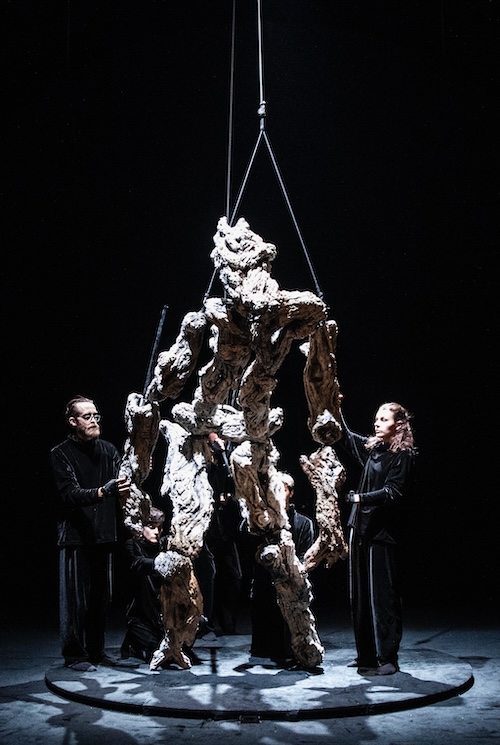COT’s “Book of Mountains and Seas” provides a unique theatrical experience but it’s not opera, Doc

Chicago Opera Theater’s production of Huang Ruo’s Book of Mountains and Seas Friday night was an impressive feat of choral singing and puppetry. But was this piece by librettist and composer Huang Ruo really an opera? If you go in expecting one, you may be disappointed.
When the lights came up at the Studebaker Theater, it felt more like the conclusion of a concert paired with abstract performance art than an opera. There were no arias, costumes, sets, or orchestra to speak of. Instead, Ruo’s work uses twelve singers, two percussionists, and six puppeteers. Clad in black velvet, they are all barely visible throughout except for the singers’ menacing faces lit from below by lights in their music folders. In the program note, Ruo says that Book of Mountains and Seas is a “work of vocal theatre.”
The title is taken from the ancient Chinese compilation of creation myths of the same name. Ruo expands four of these stories, taking original Chinese texts from the book and adding new words to flesh them out. There are no supertitles except for brief synopses projected on the back wall, meaning that unless you speak Chinese, you will not understand much being sung. But that doesn’t seem to be the point. Ruo and the creative team’s objective is not really to tell the stories but to create a soundscape and visuals that symbolize them.
As a result, the production moves quite slowly, with repetitive music and movements lulling the audience into a meditative state. While some may find this boring, the sheer technical skill required of the singers and puppeteers and the intricacy of the music may be enough to keep others engaged.
Twelve singers from Ars Nova Copenhagen were set the nearly impossible task of interpreting Ruo’s score, all while navigating a dark set. The vocal music was often one per part and unaccompanied, as the percussion, played by Michael Murphy and John Ostrowski, was largely there for effect instead of providing tonal or rhythmic context. Conductor Miles Lallemant’s ability to keep the often amorphous and highly dissonant music together was a testament to his and Ars Nova’s skill and the amount of rehearsal time it must have taken to get this show on its feet.
The upper six voices—three altos and three sopranos—tuned and blended especially well, their pure vocal production matching the etherealness of the music and helping the dissonances speak clearly. The tenors’ and basses’ earthier and sometimes nasal tones lent textural contrast but also sometimes clouded Ruo’s chord clusters.
Ruo varied the score by deploying different combinations of voices throughout. Rarely did all twelve singers sing at the same time. Instead, there was a mix of solos, duets, trios, and other ensembles of varying numbers, as well as antiphonal singing between the upper and lower halves of the choir. This variation permitted each singer to come out of the texture at given points, allowing the audience to appreciate their individual timbres.
Ruo’s musical language utilizes Chinese folk music elements, but one can hear other influences as well. One baritone solo evoked a Muslim call to prayer, while a particularly effective lower-voice ensemble in the third story recalled the spicy medieval polyphony of Machaut.
It was only midway through the third story, “The Legend of Ten Suns,” that the percussion came to the fore and began to interact with the voices in a moment of consonance with the marimba. The percussion continued to be involved in the fourth story, “Kuā Fù Chasing the Sun,” which opened with an extended bongo and bass drum solo. Then, as the tension ramped up as the puppet chased the sun, they provided rhythmic propulsion under the choir’s repetitive, John Adams-like staccato singing, making this movement the most musically fulfilling.
Presented in collaboration with the Chicago International Puppet Theater Festival, Book of Mountains and Seas promised a visual spectacle with renowned puppeteer Basil Twist as production designer and director. The visuals in the first three stories were effective at times—especially stunning was the rippling of the water in the second story, “The Spirit Bird,” and the celestial lanterns in “The Legend of Ten Suns.
Yet the visuals were largely stagnant and devoid of traditional puppets. It wasn’t until the fourth story, “Kuā Fù Chasing the Sun,” that the puppet was finally assembled and came to life.
The puppet representing Kuā Fù resembled a gnarly old tree. Recalling characters like Marvel’s Groot or Tolkien’s Ents, this puppet was more abstract in its lack of a distinct face and therefore could take on an array of emotions and energies.
In the six puppeteers’ expert hands, the puppet was surprisingly endearing as they manipulated him to chase after the sun. Coupled with the propulsive music, this moment was certainly the most exciting of the night. The lack of puppetry in the early going may have helped build anticipation, but a more representative staging in the first three stories could have brought this show more to life as a piece of theater.
Book of Mountains and Seas will be repeated 7:30 p.m. Saturday and 3 p.m. Sunday. Tickets are sold out for this production. chicagooperatheater.org
Posted in Performances


